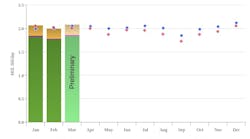On occasion, Oil & Gas Journal editors catch wind of stories that don't quite fit the typical mold of oil and gas industry news. Such items, like those having to do with the creative visual and literary arts, often find better homes in this space.
This editor decided to explore the artistic side of the industry by first checking out the book "Gaston Lays an Offshore Pipeline" by James Rice at the library. The book provides a creative way to teach children about the industry with illustrations and a rhyming format without using too many technical terms: "They X-rayed each weld—they had to be right, no burn throughs or skips—each seam must be tight."
The book's protagonist, Gaston, is a curious, friendly, green-nosed alligator from the bayou who enters a barge loaded with pipe and helps lay an offshore pipeline in the Gulf of Mexico. The crew welcomes Gaston—giving him appropriate gear that includes steel-toe boots—and teaches him about the pipelaying life: "The offshoreman's hours aren't made for the meek, from midnight ‘til noon 7 days every week."
Gaston doesn't find the life easy, but accepts every assignment with enthusiasm. Gaston takes on the job of welder, diver, and rigger to assist in obtaining oil and contribute to solving the energy crisis.
There are other books in the series, including "Gaston Drills an Offshore Oil Well," "Gaston Goes to Texas," and "Gaston Goes to Mardi Gras."
Art history, decor
The winning spirit of Texas has made the oil and gas industry in Texas what it is today—a way that benefits all, according to an art work called "Texas Fields" (circa 1900) on the web site www.westernhistoryart.com. The piece depicts an oil wagon on the way to a cable-tool rig on the open spaces of Texas. There is an early pump jack to the far right, hints of bluebonnet fields, workers' tents, a steam boiler, and a Texas longhorn looking on at the passing wagon as it heads around a deep ravine. The border has six early oil and gas photos to the right and left of the Texas Oil & Gas Historical Series seal.
Also on this web site is a work of art called "Legacy and Legends." It commemorates the oil and gas business by showing a detailed cable-tool rig with parts and company logos of today that are involved in carrying on the legacy. The main art shows an early oil field with a gusher being heralded in by a cowboy on horseback.
The art work "Historic Ventures, Pumping Power of 1920-30, Then and Now" depicts an oil field in the 1920s using the eccentric central power system. The two photographs on both sides of the center art show early rigs in their finest wood construction. The border displays the oil producing states with the year production started in the respective state and 21 early oil and gas company stock certificates with antique oil cans in the midst. There are patent drawings of drill bits and drilling apparatus rigs in the background of the piece.
John H. Martin Co. in Taylors, SC, has provided the highest quality and most unique gifts to the oil and gas drilling industry on six continents since 1937, according to its web site.
The company offers oil field-inspired belt buckles and the art work from those buckles is also used for another product—award plaque trophies that are mounted on a glossy rosewood-colored base.
Also available, is a gold-plated modern style derrick lamp. The derrick stands about 26 in. tall. In other oil and gas field office decor, it offers oil drop clocks and a blowout preventer lamp. The lamp ships with a hardhat lampshade but can be removed so that any lampshade can be used. The lamps can be customized with company logo or paint and stands about 15 in. tall.
In the jewelry section, customers will find oil and gas derrick pendants, oil well pump jack pendants, and drill bit earrings.
